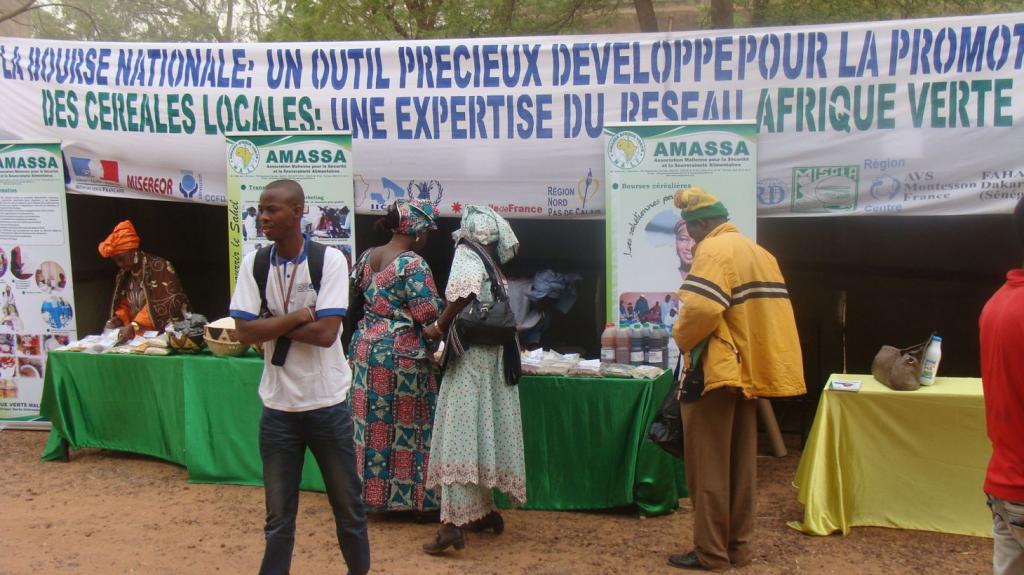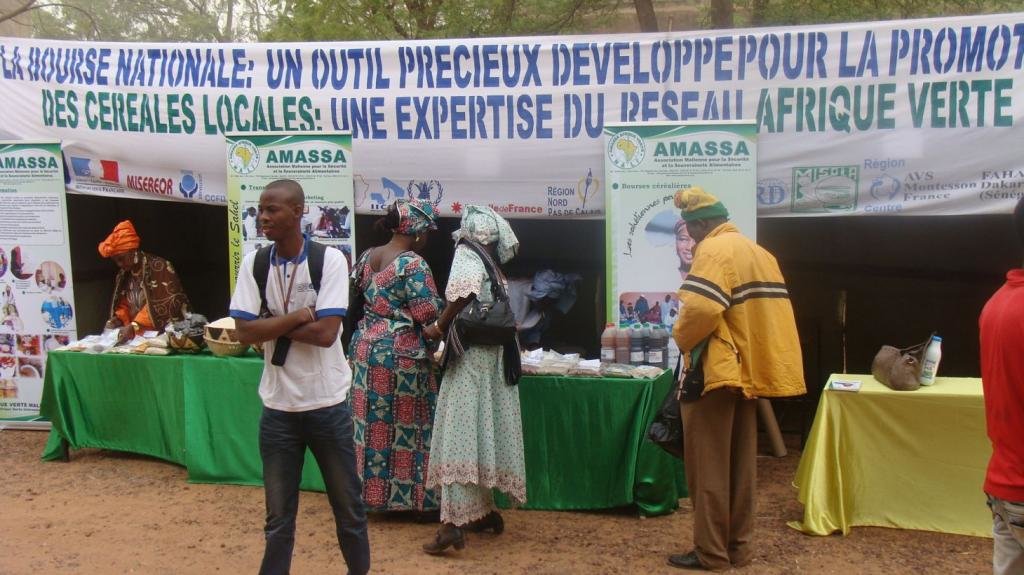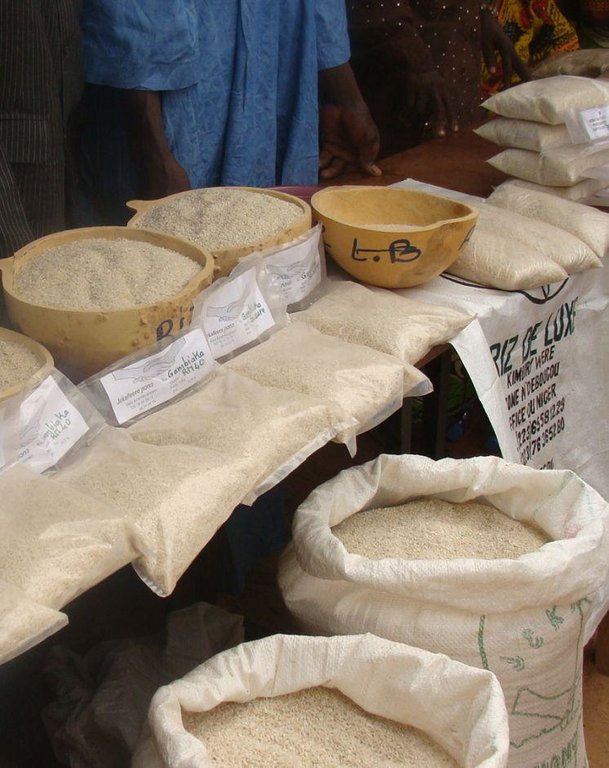Grain exchanges [มาลี]
- ผู้สร้างสรรค์:
- การอัพเดท:
- ผู้รวบรวม: Dieter Nill
- ผู้เรียบเรียง: –
- ผู้ตรวจสอบ: Laura Ebneter
Bourses aux céréales (French)
approaches_2511 - มาลี
ดูส่วนย่อย
ขยายทั้งหมด ย่อทั้งหมด1. ข้อมูลทั่วไป
1.2 รายละเอียดที่ติดต่อได้ของผู้รวบรวมและองค์กรที่เกี่ยวข้องในการประเมินและการจัดเตรียมทำเอกสารของแนวทาง
ผู้เชี่ยวชาญ SLM:
Haidara Mohamed
afriqueverte@afribone.net.ml
AMASSA - Afrique Verte Mali
มาลี
ผู้เชี่ยวชาญ SLM:
Ballo Yacouba
capi@afribone.net.ml
AMASSA - Afrique Verte Mali
มาลี
ชื่อของโครงการซึ่งอำนวยความสะดวกในการทำเอกสารหรือการประเมินแนวทาง (ถ้าเกี่ยวข้อง)
Deutsche Gesellschaft für Internationale Zusammenarbeit (GIZ) GmbH (GIZ) - เยอรมนีชื่อของโครงการซึ่งอำนวยความสะดวกในการทำเอกสารหรือการประเมินแนวทาง (ถ้าเกี่ยวข้อง)
L'Association Malienne pour la Sécurité et la Souveraineté Alimentaires - Afrique Verte Mali (AMASSA - Afrique Verte Mali) - มาลี1.3 เงื่อนไขที่เกี่ยวข้องกับการใช้ข้อมูลที่ได้บันทึกไว้ผ่านทาง WOCAT
วันที่เก็บรวบรวมข้อมูล (ภาคสนาม):
01/07/2012
ผู้รวบรวมและวิทยากรหลักยอมรับเงื่อนไขเกี่ยวกับการใช้ข้อมูลที่ถูกบันทึกผ่านทาง WOCAT:
ใช่
2. คำอธิบายของแนวทาง SLM
2.1 การอธิบายแบบสั้น ๆ ของแนวทาง
Link up production areas with the areas where grain is consumed in order to encourage the flow of cereals from one area to the other
2.2 การอธิบายอย่างละเอียดของแนวทาง
การอธิบายอย่างละเอียดของแนวทาง:
The objective of grain exchanges is to link up production areas with the areas where grain is consumed in order to encourage the flow of cereals from one area to the other. In this way, the
exchanges contribute to stabilising market prices and informing cereal producers about how these markets function.
The support structure (AMASSA – Afrique Verte Mali, a body devolved from the French NGO
Afrique Verte) invites producers and buyers to participate in a two to three-day grain exchange. This process of connecting up parties allows producers to assess grain production levels for the current season and buyers to get an idea of the grain stocks available. The two parties then negotiate grain quantities and prices. A good number of contracts are agreed during the exchange, and the agreement of further contracts after the exchange is likely. The exchange also serves to foster exchange among other actors involved in the sale and production of grain.
Organising exchanges involves several stages: First, supplies are identified in areas with high levels of dry cereal production (millet, sorghum and maize in the Sikasso, Koutiala, Ségou, Senon de Koro/Bankass plains) and rice production (in the Niono rice growing region in the Office du Niger). At the same time, the needs of consumption areas (supply cooperatives in Kayes Region and grain banks in the areas of Gao, Timbuktu and Kidal) and major consumption centres with processing plants, merchants and consumer cooperatives (such as Bamako) are identified. The supply cooperatives from rice-deficit areas (the Kayes area, for example) are identified and their needs recorded (bulk purchasing requests). Producers’ associations in the Niono region in the Office du Niger area are identified and their rice surpluses ascertained. Supplies for sale are then quantified and stockholders are encouraged to put together a bulk sales offer. Finally, a meet-and-greet workshop is held to foster exchange and discussion on grain supply and demand.
Role of stakeholders: AMASSA – Afrique Verte Mali catalogues and groups offers (purchase or sale) and cereal requirements during the pre-exchanges, and promotes the exchange among relevant cereal operators (advertising). AMASSA also provides financial and technical support in organising the exchange (venue hire, refreshments). Supply cooperatives and private operators support the process of identifying cereal requirements prior to the exchange and then participate in the exchange itself. Their role is to buy stock. Producers’ associations communicate how much of their stock is available and trade this in bulk at the exchange. The legal advisor helps draw up the sales contracts and explains the content of sales contracts to operators. Others, such as technical partners in the sector (Planning and Statistical Unit of the Ministry of Agriculture, DNSI, OMA, OPAM, Customs Service, EWS, WFP, National Agency for Food Safety and Security, etc.), provide additional specific information.
The transactions carried out in the exchanges are fairly advantageous both for the sellers (producers and their organisations) and the buyers (merchants, supply cooperatives, consumer cooperatives, processing outfits). These advantages can be measured in terms of price and quality. The grain exchanges are prized by many actors and an increasingly large number of structures have built them into their support mechanisms. The farming profession is interested in this approach. For this reason, the exchanges are increasingly being jointly delivered by APCAM and often by the Association of Professional Farming Organisations (AOPP) and projects and/or NGOs. The fact that the farming profession is appropriating the exchange concept bodes well for its sustainability.
2.3 รูปภาพของแนวทาง
2.5 ประเทศ ภูมิภาค หรือสถานที่ตั้งที่ได้นำแนวทางไปใช้
ประเทศ:
มาลี
ภูมิภาค/รัฐ/จังหวัด: :
Mali
ข้อมูลเฉพาะเพิ่มเติมของสถานที่ตั้ง:
Niono, Koutiala, Sévaré-Mopti, Ségou, Kayes
2.6 วันที่เริ่มต้นและสิ้นสุดของแนวทาง
ระบุปีที่เริ่ม:
1995
2.7 ประเภทของแนวทาง
- ใช้โครงงานหรือแผนงานเป็นฐาน
2.8 เป้าหมายหรือวัตถุประสงค์หลักของแนวทาง
The objective of grain exchanges is to link up production areas with the areas where grain is consumed in order to encourage the flow of cereals from one area to the other. In this way, the exchanges contribute to stabilising market prices and informing cereal producers about how these markets function.
The SLM Approach addressed the following problems: weak link of production areas with the areas where grain is consumed, unstable market prices
2.9 เงื่อนไขที่เอื้ออำนวยหรือเป็นอุปสรรคต่อการนำเทคโนโลยีภายใต้แนวทางนี้ไปปฏิบัติใช้
อื่นๆ
- เป็นอุปสรรค
weak link of production areas with the areas where grain is consumed
Treatment through the SLM Approach: The support structure AMASSA – Afrique Verte Mali invites producers and buyers to participate in a two to three-day grain exchange. This process of connecting up parties allows producers to assess grain production levels for the current season and buyers to get an idea of the grain stocks available. The two parties then negotiate grain quantities and prices. A good number of contracts are agreed during the exchange, and the agreement of further contracts after the exchange is likely.
3. การมีส่วนร่วมและบทบาทของผู้มีส่วนได้ส่วนเสียที่เกี่ยวข้อง
3.1 ผู้มีส่วนได้ส่วนเสียที่เกี่ยวข้องในแนวทางนี้และบทบาท
- ผู้ใช้ที่ดินระดับท้องถิ่นหรือชุมชนระดับท้องถิ่น
- ผู้เชี่ยวชาญ SLM หรือที่ปรึกษาการเกษตร
- องค์กรพัฒนาเอกชน
- รัฐบาลระดับท้องถิ่น
- รัฐบาลแห่งชาติ (ผู้วางแผน ผู้ทำการตัดสินใจ)
3.2 การเกี่ยวข้องของผู้ใช้ที่ดินระดับท้องถิ่นหรือชุมชนระดับท้องถิ่นในช่วงต่างๆของแนวทาง
| ความเกี่ยวข้องของผู้ใช้ที่ดินระดับท้องถิ่นหรือชุมชนระดับท้องถิ่น | ระบุผู้ที่มีส่วนเกี่ยวข้องและอธิบายกิจกรรม | |
|---|---|---|
| การริเริ่มหรือการจูงใจ | ไม่ลงมือ | |
| การวางแผน | ปฏิสัมพันธ์ | |
| การดำเนินการ | ปฏิสัมพันธ์ | |
| การติดตามตรวจสอบหรือการประเมินผล | ปฏิสัมพันธ์ | |
| Research | ไม่ลงมือ |
3.4 การตัดสินใจเลือกใช้เทคโนโลยี SLM
ระบุผู้ที่ทำการตัดสินใจเลือกเทคโนโลยีมากกว่าหนึ่งวิธีไปปฏิบัติใช้:
- ผู้ใช้ที่ดินเป็นผู้ตัดสินใจหลัก โดยการสนับสนุนจากผู้เชี่ยวชาญ SLM
การอธิบาย:
Decisions on the method of implementing the SLM Technology were made by mainly by SLM specialists with consultation of land users
4. การสนับสนุนด้านเทคนิค การสร้างขีดความสามารถ และการจัดการด้านความรู้
4.1 การสร้างขีดความสามารถ / การอบรม
ได้มีการจัดอบรมให้แก่ผู้ใช้ที่ดินหรือผู้มีส่วนได้ส่วนเสียคนอื่น ๆ หรือไม่:
ใช่
ให้ระบุว่าใครเป็นผู้ได้รับการอบรม:
- ผู้ใช้ที่ดิน
รูปแบบการอบรม:
- กำลังดำเนินการ
- เกษตรกรกับเกษตรกร
- จัดการประชุมสู่สาธารณชน
หัวข้อที่พูด:
Before each workshop, facilitators from AMASSA – Afrique Verte Mali ascertain the grain needs of consumer regions in order to bulk together orders to the different supply cooperatives and grain banks. Likewise, producers’ available grain stocks are ascertained and bulked to build a substantial supply. To ascertain the needs of the parties involved, AMASSA – Afrique Verte Mali organises forums in the main production areas called ‘pre-exchanges’. These pre-exchanges are, in effect, regional preparatory meetings where around 80 to 100 people come together to assess the offers available and the approaches for bulking supply and demand.
In addition, facilitators use the pre-exchanges to train organisations in market negotiation techniques, price setting and drawing up sales contracts. An area of particular focus is the content of contracts (delivery deadlines, quality and standards to be delivered, quantities, packaging requirements, etc.) and the consequences of failing to meet the terms of the contract. A series of pre-exchanges are rolled out in different locations.
In practice, the exchanges serve as platforms for information exchange that give operators the opportunity to get up to speed with certain key aspects of the trade. They provide information on the status of cereal production, areas facing food scarcity or economic difficulties, cereal price trends, legislative and regulatory procedures relating to cross-border trade, invitation to tender opportunities for replenishing the National Security Stock (SNS) and sales of intervention stocks. This range of information is essential and enables operators to better position themselves in the grain market.
4.2 การบริการให้คำแนะนำ
ผู้ใช้ที่ดินมีการเข้าถึงการรับบริการให้คำปรึกษาหรือไม่:
ใช่
การอธิบาย/แสดงความคิดเห็น:
Advisory service is quite adequate to ensure the continuation of land conservation activities
4.3 การเสริมความแข็งแกร่งให้กับสถาบัน (การพัฒนาองค์กร)
สถาบันได้รับการจัดตั้งขึ้นมาหรือเสริมความแข็งแกร่งโดยแนวทางนี้หรือไม่:
- ใช่ ปานกลาง
ระบุระดับของสถาบันที่ได้รับการเสริมความแข็งแกร่งหรือจัดตั้งขึ้นมา:
- ท้องถิ่น
ระบุประเภทของการให้ความช่วยเหลือสนับสนุน:
- ด้านการเงิน
- การสร้างขีดความสามารถ / การอบรม
4.4 การติดตามตรวจสอบและประเมินผล
การติดตามตรวจสอบและประเมินผลเป็นส่วนหนึ่งของแนวทางหรือไม่:
ใช่
ความคิดเห็น:
economic / production aspects were regular monitored by project staff, land users through measurements
management of Approach aspects were regular monitored by project staff, land users through observations
There were no changes in the Approach as a result of monitoring and evaluation
There were no changes in the Technology as a result of monitoring and evaluation
4.5 การวิจัย
การวิจัยเป็นส่วนหนึ่งของแนวทางหรือไม่:
ใช่
ระบุหัวข้อเรื่อง:
- เศรษฐศาสตร์หรือการตลาด
5. การสนับสนุนด้านการเงินและวัสดุอุปกรณ์
5.1 ระบุงบประมาณประจำปีสำหรับแนวทาง SLM นี้
แสดงความคิดเห็น (แหล่งของการระดมทุน ผู้บริจาคคนสำคัญ):
Approach costs were met by the following donors: national non-government: 100.0%
5.2 การสนับสนุนด้านการเงิน / วัสดุอุปกรณ์ให้แก่ผู้ใช้ที่ดิน
ผู้ใช้ที่ดินได้รับการสนับสนุนด้านการเงิน / วัสดุอุปกรณ์ไปปฏิบัติใช้เทคโนโลยีหรือไม่:
ไม่ใช่
5.3 เงินสนับสนุนสำหรับปัจจัยนำเข้า (รวมถึงแรงงาน)
ถ้าแรงงานโดยผู้ใช้ที่ดินเป็นปัจจัยนำเข้าที่มีอยู่มากมาย ระบุด้วยว่าเนื่องจาก:
- สมัครใจ
5.4 เครดิต
มีการจัดหาเครดิตมาให้ภายใต้แนวทาง SLM หรือไม่:
ไม่ใช่
6. การวิเคราะห์ผลกระทบและการสรุป
6.1 ผลกระทบของแนวทาง
ช่วยให้ผู้ใช้ที่ดินนำเอาเทคโนโลยี SLMไปใช้และบำรุงรักษาสภาพไว้ได้หรือไม่:
- ไม่ใช่
- ใช่ เล็กน้อย
- ใช่ ปานกลาง
- ใช่ อย่างมาก
Product quality improves and becomes more standardised
ทำให้กลุ่มด้อยโอกาสมีอำนาจทางสังคมและเศรษฐกิจหรือไม่:
- ไม่ใช่
- ใช่ เล็กน้อย
- ใช่ ปานกลาง
- ใช่ อย่างมาก
Did other land users / projects adopt the Approach?
- ไม่ใช่
- ใช่ เล็กน้อย
- ใช่ ปานกลาง
- ใช่ อย่างมาก
AMASSA – Afrique Verte Mali began operations in Mali in 1994 and the first exchanges took place in 1995. AMASSA – Afrique Verte Mali organises several exchanges each year in Mali: One exchange in Niono to supply Kayes Region and urban centres like Bamako with rice from the surplus area of Office du Niger. This exchange only involves parties interested in trading rice. One exchange in Koutiala in South Mali to supply regions in the north of Mali (Gao, Timbuktu and Mopti) and major consumption centres in Bamako with dry cereals (particularly maize, millet and sorghum derived from the surplus area of Sikasso). One exchange in Sévaré-Mopti to supply regions in the north of Mali (Gao, Timbuktu and Mopti) with dry cereals (particularly millet and sorghum derived from the surplus area of the Séno de Koro plains). One national exchange in Ségou involving all national cereal operators (producers, farmer organisations, cereal processing plants, cereal merchants, logistics companies, institutional market structures and technical partners). This exchange involves all tradable cereals (rice, millet, sorghum, maize, fonio and others). Two regional exchanges within the Kayes region (Kita and Diéma). These exchanges enable deficit areas to source dry cereals regionally in Kita and Diéma. Kita and Diéma are considered surplus areas in the Kayes region. One international exchange that involves several countries. The last international exchange was organised on 13 and 14 December 2011 in Bamako with nine ECOWAS countries participating. The exchange resulted in the sale of 50,000 tonnes of grain for more than 8 billion CFA francs. The international exchange involves 200 participants and the trading of 50,000 tonnes of grain between cereal operators from participating countries. The exchanges are increasingly being jointly delivered by APCAM and often by the Association of Professional Farming Organisations (AOPP) and projects and/or NGOs. Grain exchanges have attracted the interest of many actors in the cereals sector. Interest is so high that a host of organisations have expressed the desire to hold their own grain exchanges (e.g. chambers of agriculture, cereals sector support projects and programmes, decentralised authorities).
Did the Approach lead to improved livelihoods / human well-being?
- ไม่ใช่
- ใช่ เล็กน้อย
- ใช่ ปานกลาง
- ใช่ อย่างมาก
The exchanges help producers and consumers agree preferential prices without the need for intermediaries with the aim of reducing the cost of cereals in consumer areas and increasing it in production areas. Product quality improves and becomes more standardised, regular interaction increases client loyalty, and there is greater structuring of producers and consumers.
Did the Approach help to alleviate poverty?
- ไม่ใช่
- ใช่ เล็กน้อย
- ใช่ ปานกลาง
- ใช่ อย่างมาก
Each exchange in Niono, Sévaré-Mopti, Koutiala involves between 70 and 80 participants, representing nearly 120 villages. The transactions effected are viable. Niono exchange: between 2,000 and 3,000 tonnes per year; Sévaré-Mopti exchange: between 800 and 1,500 tonnes per year; Koutiala exchange: between 1,500 and 2,500 per year.The Diéma and Kita exchanges involve around 50 people, with around 80 to 120 tonnes of cereals sold at each yearly exchange. The yearly Ségou national exchange involves around 150 to 200 operators in the cereals sector. 9,000 to 15,000 tonnes of cereals (millet, sorghum, maize and fonio) are sold at the event each year.
6.2 แรงจูงใจหลักของผู้ใช้ที่ดินเพื่อที่จะนำ SLM ไปปฏิบัติใช้
- การผลิตที่เพิ่มขึ้น
- กำไร (ความสามารถ) อัตราส่วนค่าใช้จ่ายต่อผลประโยชน์ที่เพิ่มขึ้น
6.3 ความยั่งยืนของกิจกรรมของแนวทาง
ผู้ใช้ที่ดินสามารถทำให้สิ่งต่างๆ ที่ได้ปฏิบัติใช้โดยแนวทางนี้ยั่งยืนได้หรือไม่ (โดยไม่มีการสนับสนุนจากภายนอก):
- ใช่
6.4 จุดแข็งและข้อได้เปรียบของแนวทาง
| จุดแข็ง / ข้อได้เปรียบของแนวทางในทัศนคติของผู้รวบรวมหรือวิทยากรหลัก |
|---|
|
The exchanges help producers and consumers agree preferential prices without the need for intermediaries with the aim of reducing the cost of cereals in consumer areas and increasing it in production areas. Product quality improves and becomes more standardised, regular interaction increases client loyalty, and there is greater structuring of producers and consumers. For example, the apex organisations in Niono (20 rice grower organisations collectively called ‘Jèka Feeré’) and in Yalimenané (28 supply cooperatives collectively called ‘Supunu Kafô’) have been set up as a result of the exchange system. (How to sustain/ enhance this strength: Successful exchanges require: 1) the organisation of producers and buyers to increase supply and demand; 2) bulk purchasing approaches to secure lower prices; 3) the formalisation of purchase contracts and cereal logistics; 4) the origins of merchandise to be traceable; 5) contractual agreements to be respected in terms of quality, payment methods and deadlines, delivery deadlines and methods, etc.) |
| The exchanges enable people working in the sector get to know the main challenges in trading cereals. They therefore constitute a suitable framework for advocacy activities (advocacy platform) where actors involved in the sector have the opportunity to communicate directly with leading figures in the sector and to defend their interests in terms of the production and sale of cereals. |
|
grain exchanges have attracted the interest of many actors in the cereals sector. Interest is so high that a host of organisations have expressed the desire to hold their own grain exchanges (e.g. chambers of agriculture, cereals sector support projects and programmes, decentralised authorities). Currently, exchanges – in particular, the national grain exchange – are jointly delivered by AMASSA – Afrique Verte Mali and the Permanent Assembly of the Mali Chambers of Agriculture (APCAM). (How to sustain/ enhance this strength: The critical factor in making these exchanges genuinely successful is ensuring their sustainability, i.e. ensuring that their main beneficiaries (producer organisations, processing outfits, cooperatives, grain banks, merchants and animal food manufacturers) take financial and political ownership of the exchanges. Beneficiaries across the board recognise that the tool is useful and necessary. But how, with what means and when will these parties take over the organisation of exchanges and cover all the costs involved (organisation, facilitation, technical support)? It remains to be seen how these actors will be able to take on this responsibility in the short or medium term given the frequently low incomes among producer organisations, and particularly among those in rice-deficit areas. On the other hand, it is certainly possible over the medium term to maintain partial ownership and to foster a gradual shift towards ownership by producer organisations and operators through the progressive increase of their contributions. Setting up partnerships involving support for organisations and programmes operating in the sector is also a viable option. The sustainability of this approach depends on it being fully appropriated by the beneficiaries themselves, so that AMASSA – Afrique Verte Mali becomes merely a provider of technical know-how.) |
6.5 จุดอ่อน / ข้อเสียเปรียบของแนวทางและวิธีในการแก้ไข
| จุดอ่อน / ข้อเสียเปรียบในทัศนคติของผู้รวบรวมหรือวิทยากรหลัก | สามารถแก้ไขปัญหาได้อย่างไร |
|---|---|
| a certain level of expertise is required to organise and run the exchanges in a way which ensures they deliver all their desired outcomes |
7. การอ้างอิงและการเชื่อมต่อ
7.1 วิธีการหรือแหล่งข้อมูล
- ไปเยี่ยมชมภาคสนาม การสำรวจพื้นที่ภาคสนาม
- การสัมภาษณ์กับผู้ใช้ที่ดิน
7.2 การอ้างอิงถึงสิ่งตีพิมพ์
ชื่อเรื่อง ผู้เขียน ปี ISBN:
Manual of Good Practices in Small Scale Irrigation in the Sahel. Experiences from Mali. Published by GIZ in 2014.
ช่องทางในการสืบค้น และราคา:
http://star-www.giz.de/starweb/giz/pub/servlet.starweb
ชื่อเรื่อง ผู้เขียน ปี ISBN:
Afrique Verte activity reports
ชื่อเรื่อง ผู้เขียน ปี ISBN:
Find out more at: www.afriqueverte.org
ลิงก์และโมดูล
ขยายทั้งหมด ย่อทั้งหมดลิงก์
ไม่มีลิงก์
โมดูล
ไม่มีโมดูล




